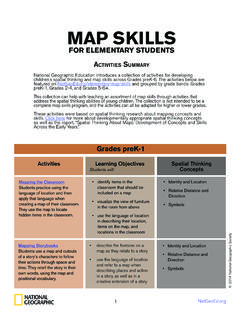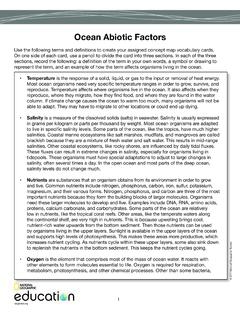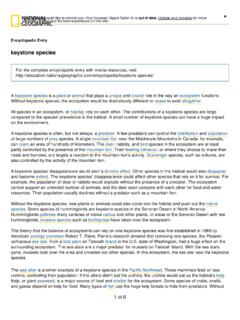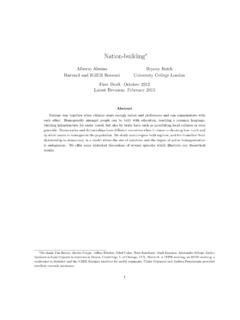Transcription of Migration of Jews to Palestine in the 20th Century
1 2012 National Geographic SocietyRead the text Jewish people historically defined themselves as the Jewish Diaspora, a group of people living in exile. Their traditional homeland was Palestine , a geographic region on the eastern coast of the Mediterranean Sea. Jewish leaders trace the source of the Jewish Diaspora to the Roman occupation of Palestine (then called Judea) in the 1st Century CE. Fleeing the occupation, most Jews immigrated to the centuries, Jews began to slowly immigrate back to Palestine . Beginning in the 1200s, Jewish people were expelled from England, France, and central Europe.
2 Most resettled in Russia and Eastern Europe, mainly Poland. A small population, however, immigrated to Palestine . In 1492, when King Ferdinand and Queen Isabella expelled all Jewish people living in Spain, some refugees settled in Palestine . At the turn of the 20th Century , European Jews were migrating to Palestine in large numbers, fleeing religious persecution. In Russia, Jewish people were segregated into an area along the country s western border, called the Pale of Settlement. In 1881, Russians began mass killings of Jews. The mass killings, called pogroms, caused many Jews to flee Russia and settle in Palestine .
3 Prejudice against Jews, called anti-Semitism, was very strong in Germany, Austria-Hungary, and France. In 1894, a French army officer named Alfred Dreyfus was falsely accused of treason against the French government. Dreyfus, who was Jewish, was imprisoned for five years and tried again even after new information proved his innocence. The incident, called The Dreyfus Affair, exposed widespread anti-Semitism in western Europe. The Dreyfus Affair convinced Theodor Herzl, an Austrian Jewish journalist, that Jewish people needed to have their own homeland to be free of religious persecution. He organized the First Zionist Congress in 1897 and is credited with starting the Zionist movement.
4 Zionism holds that an independent Jewish state is the only way for Jewish people to escape anti-Semitism. By the mid-1900s, anti-Semitism had developed into a powerful political force in Europe. In the early 1930s, more than 100,000 Jewish refugees came to Palestine from Nazi Germany and Poland. Zionism gained always considered Palestine to be the site of their independent Jewish state. It is the historical homeland of the Jewish people. Many sites identified in the Hebrew holy book, the Torah, remained cities and towns in early 20th Century Palestine . Many scholars say the Iron Age kingdoms of Israel and Judah, with their capital in Jerusalem, were Jewish kingdoms.
5 By the time of the Roman occupation, Judea was a largely Jewish the early 1900s, Palestine was controlled by the Ottoman Empire. It was a sparsely populated territory, mostly inhabited by Arabs. Arabs are an indigenous culture throughout Migration of Jews to Palestine in the 20th of Jews to Palestine in the 20th Century , continuedNorth Africa and the Middle East. Most Arabs in Palestine are Muslim or Christian. (Jews native to Arab areas are known as Mizrahi Jews.)Arabs opposed Zionism, which they associated with the Migration of European Jews to Palestine . This opposition was motivated by anti-Semitism, as well as fear about the loss of their own Arab or Ottoman identity, rights, and World War I, the Ottoman Empire dissolved and Palestine became part of the United Kingdom.
6 The United Kingdom supported Zionism. Palestinians revolted, and the conflict between Arabs and Zionists continued throughout World War II, as more Jews tried to flee the Holocaust in Europe. In 1947, the United Nations split Palestine up into Arab and Jewish areas. The nation of Israel was created on May 14, 1948. The next day, the countries surrounding Israel declared war on the new nation. Israel has been in an almost permanent state of internal conflict ever since. Many Palestinians moved to refugee camps. Conflict between Jews, who identify as Israeli, and Arabs, who identify as Palestinian, broke out again in 1956, 1967, 1987, and 2000.
7 Today, Israel is a land of immigrants. About million people live in Israel, almost 80 percent of them Jewish. Most are Ashkenazi Jews, who migrated from Europe. Sephardic Jews migrated from the Iberian Peninsula. Bukharan Jews migrated from Central Asia. Israel continues to welcome Jewish immigrants. The nation s Law of Return grants full Israeli citizenship to all Jewish people. More than 100,000 Jews from sub-Saharan Africa, for instance, have immigrated to Israel since 1980. Sources Bard, Mitchell, and Schwartz, Moshe. 1001 Facts Everyone Should Know About Israel. Lanham, Maryland: Rowman and Littlefield Publishers, Inc.
8 , Book Encyclopedia. 2012 National Geographic Society









